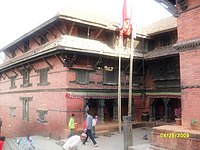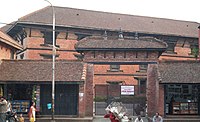Gorkha Palace
The Gorkha Palace located in the Gorkha district of Nepal is a historic landmark built in the 16th century by Ram Shah.[1][2] The palace is built on top of a hill at an altitude of about 1000 meter. This palace is an hour walk from the downtown Gorkha bazaar.
The palace is the birthplace of the king Prithvi Narayan Shah who was born in 1723 and started the movement of the unification of Nepal. Prithvi Narayan Shah was born in the Dhuni Pari, which is a part of the Palace.[3]
The Palace
The palace lies on the hilltop and is completely fortified. It is an example of Newari architecture. The walls of the palace are about three feet thick. The floors are supported by extended wooden beams.[4]

Temples inside and near the Palace
Gorkha Durbar also has religious importance due to the placement of various Hindu temples inside the palace.
In the western part of the palace lies Kalika temple which was built during the 17th century.[1] The temple has wooden carvings of birds, animals and deities. Only hindus are allowed inside the temple after removing any items made from leather, else even Hindus are also not allowed.
The temple of Goddess Gorakhkali lies on the southwestern side of the palace.

The Goraknath temple is located near the Gorakhali temple. Goraknath was a Hindu yogi who was an influential founder of the Nath Hindu movement and also one of the two notable disciples of Matsyendranath. This place holds a fair every year on the day of Baisakh Purnima (the full moon day on the month of Baisakh) in Gorakhnath Cave. There is also a cave that is claimed as the shelter of the statue of Gorakhnath, the Tantric sage.[1]

Museum
The museum located inside the premises of the palace houses various items including armours, paintings and the Divya Upadesh of Prithvi Narayan Shah.

Surroundings
The palace also serves as a viewpoint to observe Mt. Manaslu, Mt. Himalchuli, Mt. Annapurna and Ganesh peaks of the Himalayas in the Northern side while planes of Gorkha and surrounding villages in the southern side.
The “eternal flame” lies on the southern part of the palace which has been lit since the unification of Nepal.
Impact of 2015 earthquake
The April 2015 Nepal earthquake partially damaged the palace. It took over two years for the reconstruction process to start by the Department of Archeology and repair work started in November 15, 2017. As of 2020, the repair work is still ongoing.[2]

Tourism
According to the Gorkha Museum, 48,233 people visited the palace in 2015-2016. In 2016-2017 it had 72,648 visitors and in 2017-2018 there were 77,753 visitors.[2]
See also
References
- "Gorkha: The Historical Landmark of Nepal". Nepal Sanctuary Treks. 2018-09-10. Retrieved 2020-06-15.
- "Four years since the earthquake, Gorkha Durbar still in ruins". Retrieved 2020-06-15.
- "Gorkha Durbar". Lonely Planet. Retrieved 15 June 2020.
- Bernier, R.M.; Bstan-ʼdzin-rgya-mtsho, XIV (1997). Himalayan Architecture. Fairleigh Dickinson University Press. ISBN 978-0-8386-3602-2.